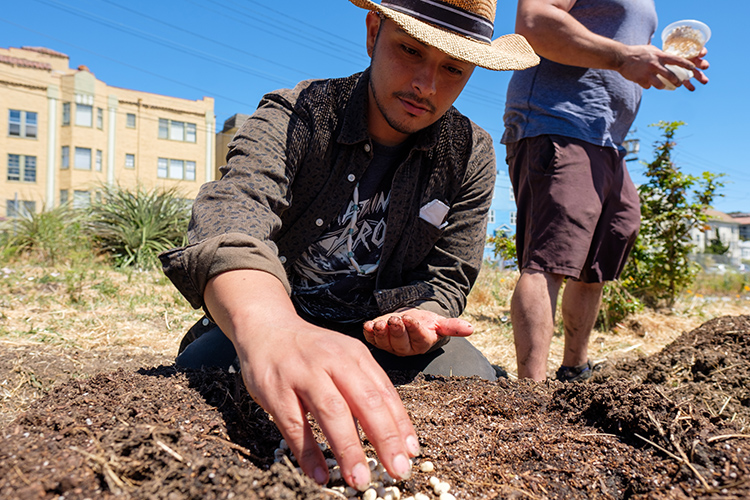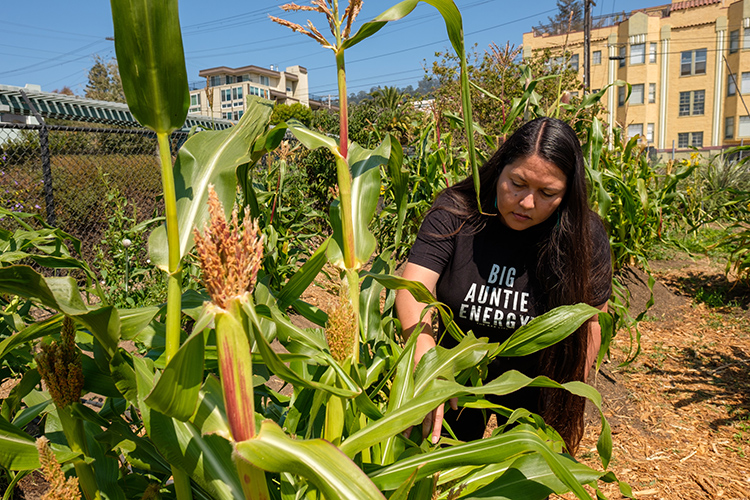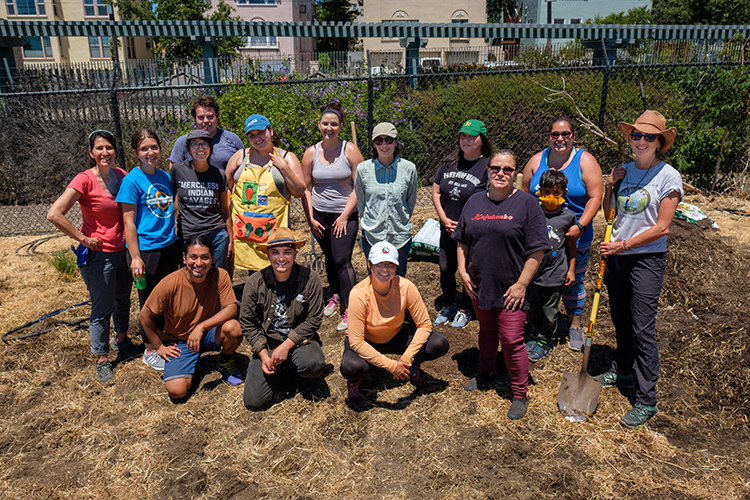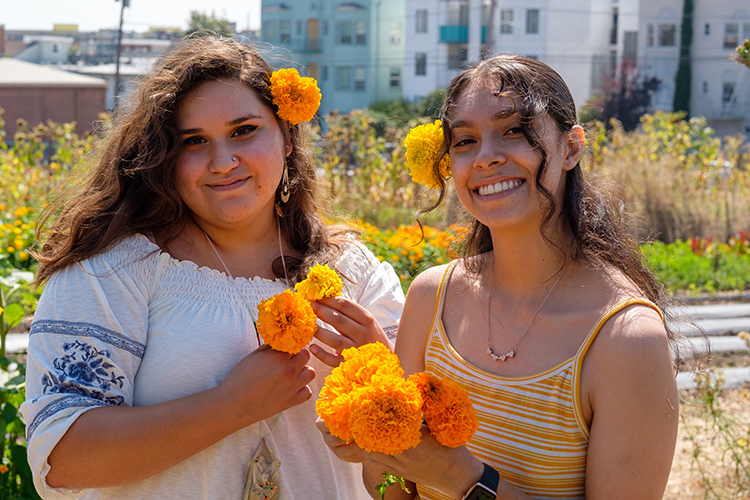Berkeley’s new Indigenous Community Learning Garden takes root
The Oxford Tract plot, a former bee garden, is for Indigenous students to meet, learn, research, remember and grow
October 12, 2021

Student Jesmane Sanches admiringly examines a sunflower growing in the new Indigenous Community Learning Garden in the Oxford Tract. Nearby, Adina Lewis waters some of the many native plants growing there this fall. (UC Berkeley photo by Adam Sings in the Timber)
There’s a new garden at UC Berkeley, but for Adina Lewis and other Indigenous people in the campus community, it’s much more than flora and fauna. The Indigenous Community Learning Garden is a place where both they and native plants can connect and thrive.
On 1,050 square feet in the Oxford Tract, at the campus’s northwest corner, the four-month-old garden boasts Dakota Ivory corn, Cherokee Purple tomatoes, Chiletepin peppers, California buckwheat, tree mallow, white sage, native California grapes, California brittlebush and many other Indigenous and California native plants. Since June, students have been planting, tending and harvesting the crops, documenting their work, and learning and sharing stories about gardening done by their ancestors.
On a recent afternoon, Lewis, a fifth-year microbial biology major, checked the heartiness of the “three sisters”— corn, beans and squash — growing there as companions and in mounds, not rows. Many Native American groups have long planted these food staples together, with cornstalks forming a trellis for the beans, which convert nitrogen from the air into a soil-bound form especially useful to corn, and huge squash leaves carpeting the ground, preventing weed growth and the evaporation of soil moisture.

Corn, beans and squash are growing robustly as close companions in the garden, where the “three sisters” style of planting was used. The stacked method draws upon Native American agricultural traditions and expertise. (UC Berkeley photo by Adam Sings in the Timber)
Nearby, bees visited Seneca and Arikara sunflowers, a nutritious herb called purslane provided ground cover to create a humid microclimate for nearby species, and milkweed, a disappearing plant used in basketmaking, offered a favorite habitat for monarch butterflies, which lay eggs on their hosts.
“These plants have relationships with each other, they have their own minds,” said Lewis, a descendant of the Cold Springs Rancheria of Mono Indians of California, whose traditional homeland is in the southern Sierra Nevada foothills. “What we’re doing here is trying to teach folks Indigenous ways of gardening. It’s farming in the very best way.”
Indigenous students have long requested a garden space from the campus, said Phenocia Bauerle, director of the Native American Student Development office at Berkeley, “and a big, underlying desire was to have more connection to traditional gardening practices and knowledge. Some students don’t have any experience, but want to learn. Then, there are students in the sciences, like microbiology or chemistry, who want to connect, but also to apply traditional knowledge and research methods to gardening.”

On a work day at the garden this past summer, members of Berkeley’s Indigenous community got to work sowing seeds that have now become a wide variety of Indigenous and California native plants. (UC Berkeley photo by Adam Sings in the Timber)
A member of the Apsáalooke tribe, Bauerle, a co-sponsor of the garden, said she learned traditional foodways — including food gathering, production, preservation and preparation — from her grandfather and great-grandparents. “A lot of people didn’t have that, a sense of how the environment was,” she said. “What I’m looking forward to is seeing students gaining knowledge they didn’t know they were missing out on.”
The garden space, the same one Berkeley professor Gordon Frankie used for 15 years as an experimental floral resource garden to research native bee species’ plant preferences, is necessarily tied to research and academic coursework, as are the other Oxford Tract plots.
This fall, students are earning field study credits through the Department of Environmental Science, Policy and Management (ESPM) to establish the Indigenous Community Learning Garden, plant and harvest a variety of foods and herbs, learn concepts of plant growth for cultivated and Indigenous species, and discover traditional Indigenous uses of native species. At monthly community feasts, they will present their takeaways to the Indigenous community on campus and its off-campus partners.

Associate professor Elizabeth Hoover is a co-sponsor of the garden, which her spring 2022 course, “Indigenous Food Sovereignty,” will use to give students the chance to learn more about native food plants and traditional methods of horticulture. (UC Berkeley photo by Adam Sings in the Timber)
Next spring, ESPM associate professor Elizabeth Hoover’s “Indigenous Food Sovereignty” course will use the garden to give students the opportunity to learn more about native food plants and professional methods of horticulture.
Students approached Hoover to help co-sponsor the garden shortly after she moved to Berkeley from New England in late October 2020, and when she toured the Oxford Tract space, “I said, ‘This is amazing. I’d love to work on this,” said Hoover. She then collaborated with the students and Bauerle and applied to the College of Natural Resources to acquire the field space; the application was approved last spring.
Examples of the research projects that students might conduct at the site, said Hoover, include cultivating edible geophytes — Indian potatoes, soaproot, camus, onions and other brodiaeas — that declined after Indigenous stewardship practices were restricted or removed by settler colonists in California, and exploring the impact of agricultural practices and livestock on geophytes’ habitats.

Phenocia Bauerle, director of the Native American Student Development office, is another co-sponsor of the garden. She learned about traditional foodways from her grandfather and great-grandparents. (UC Berkeley photo by Adam Sings in the Timber)
Hoover, who is of Mohawk descent and grew up on a little farm in upstate New York, also said research also could be done on how perennial, drought-tolerant and milpa, another term for three sisters, mixed farming methods can reduce labor inputs, increase plant adaptability and provide culturally relevant foods.
For Indigenous students with a horticultural background, said Hoover, the garden is a place where they can bring their seeds and “stay connected with the plants and crops important to them.” At the garden, Hoover herself has contributed buckskin brown beans, an heirloom variety good for a three sisters garden, and she sprouted Kabocha squash seeds from a farmer’s market.
Students gardening together at the site often talk about plants grown by older family members and uses of them, including baby sage to make tea and desert globemallow to soothe the lungs and stomach. Recently, student Jesmane Sanches, who works regularly in the garden, reminisced about their grandmother’s talent at growing heirloom roses, while Lewis remarked about milkweed’s use in basket-making and for attracting pollinators. Nearby, Joshua Hoyt sprayed plants with a homemade remedy for powdery mildew.

Peppers of many kinds grow in the Indigenous Community Learning Garden. (UC Berkeley photo by Adam Sings in the Timber)
“Grandmother’s house was covered in roses,” said Sanches. “She worked in the agricultural industry, in the fields.”
Said Lewis, “We all have some knowledge passed down, creation stories,” adding that the Indigenous community at Berkeley is building the garden as “labors of love.”
Bauerle said she hopes the stories and planting know-how being shared in the garden will become “common knowledge.” She added that guests to the garden and the campus are adding to that knowledge base. For example, the owners of Café Ohlone, a Berkeley restaurant committed to the cuisine of the Indigenous Ohlone people of Northern California, have toured the garden and talked with students about the café’s take on Indigenous dishes utilizing traditional ingredients, such as acorns, mushrooms, hazelnut flour and sunflower seed oil.

A group of gardeners gathered for a work day earlier this year at the new Indigenous Community Learning Garden. (UC Berkeley photo by Adam Sings in the Timber)
A core of about 15 people is maintaining the garden, and Hoyt, a program coordinator for the American Indian Child Resource Center’s Preparing Oakland Native Youth Program and who is of Italian and Native American descent — Métis from the Turtle Mountain Band of the Chippewa and Yankton Sioux tribes — was hired for his knowledge of traditional plants and foods. The former professional chef, now a researcher and educator, is busy building a guide to what’s planted and will be planted there, along with the plants’ common and scientific names; edible, cultural and medicinal uses; pollinator and wildlife values; and drought tolerance.
“This is beyond just a community or student garden, it’s not hobby stuff,” said Bauerle. “Students want a faculty member who is willing to teach and provide field units for students who want to work there and learn about foods and how they were prepared.”
The garden also may become a place for Indigenous people external to the Berkeley campus, such as the Café Ohlone owners, to partner with the garden and hold events, she said, like educational tea workshops and “other possibilities for learning lost by colonization efforts.”

“What we’re doing here is trying to teach folks Indigenous ways of gardening,” said student Adina Lewis (right), posing with Jesmane Sanches. “It’s farming in the very best way.” (UC Berkeley photo by Adam Sings in the Timber)
Unfortunately, the Indigenous Community Learning Garden does not have a permanent space in the Oxford Tract. Each year, an application will be required to propose continued research and teaching there.
But Bauerle believes that the garden, unique in its focus on growing Indigenous plants, and also because it’s student-led — “Gardens like this just don’t exist,” she said — has a future at Berkeley.
“There’s a lot of potential to make this a long-term project, as long as we keep coordinating with Liz and others who want to be involved,” she said. “A lot of potential.”